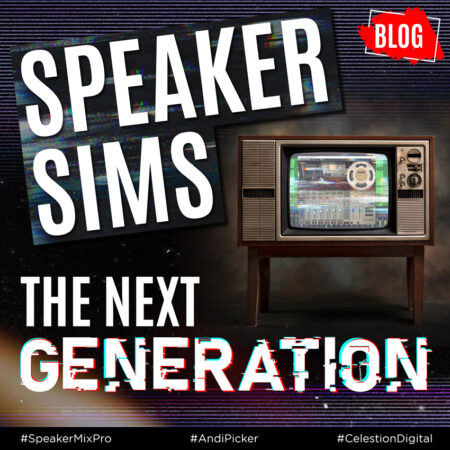 In our latest blog, Andi Picker discusses the next generation of speaker simulation, and what our brand-new SpeakerMix Pro plugin and range of Dynamic Speaker Responses (DSRs) bring to the mix.
In our latest blog, Andi Picker discusses the next generation of speaker simulation, and what our brand-new SpeakerMix Pro plugin and range of Dynamic Speaker Responses (DSRs) bring to the mix.
I’m a long-term fan of speaker IRs – when I reviewed the original release of Celestion Impulse Responses way-back in issue 50 of Guitar Interactive magazine I praised their sound and commented that “Just by way of a suggestion, I do think it would be useful if Celestion provided an impulse loader to complete the package: “. Well, they’ve done it, and they’ve taken the IR concept a step further than I imagined.
SpeakerMix Pro + DSRs = Dynamic Speaker Responses
Celestion’s SpeakerMix Pro plugin (VST, AAX, AU) is a high-performance IR loader and mixer, but it does something more – it also hosts Celestion’s new DSRs – Dynamic Speaker Responses, and they do something that I’ve not seen (or heard) anywhere else. So, what’s a DSR, and what does it do for us?
The Real Thing
It’s all about making the digital speaker behave more like a real piece of hardware. The physical construction of a speaker gives it a characteristic frequency response; feed a signal into the speaker and we hear a sound that is filtered by the mechanics of the speaker – put that speaker into a cabinet and the size and construction of the box effects the impedance curve of the speaker so we hear an altered frequency response. These characteristics are capably captured by an Impulse Response – a snapshot of the performance of a specific speaker in a specific cabinet captured by a specific microphone in a specific place.
The Fine Detail
There is, however, a nuance of speaker response that IRs don’t capture – how hard is our signal actually hitting the speaker at any given moment? The cone of a speaker that’s getting a low level signal stays pretty much the same shape as it moves in and out to push and pull the air around it and create the sound that we hear, but as we play louder, that cone doesn’t only move further forwards and backwards, it also changes shape from moment to moment as it pumps and ripples and shakes – and this extra movement adds complexity and character to the sound – it’s part of the reason why loud amps are so exciting and why our choice of speakers has such a massive effect on the final sound.
Bringing Back the Dynamics
Standard IRs are created by playing an Impulse signal through the cabinet that we want to sample and recording the Response sound that it creates – each IR is a single set-up captured at a single level. If we want separate IRs for loud and for quiet parts that’s OK, they can be recorded with different signals, but there’s really no way that they can reproduce the nuance of dynamic playing where one note is whisper quiet and the next a full-on scream. A DSR can (remember – that D stands for Dynamic), it responds to the actual signal level in real time – as it plays, and that can be a big-deal, especially in how the response of the simulation “feels” with dynamic playing.
KISS – Keep It Simple…
When I can’t make a lot of noise with real cabs (a big issue at the moment, working from home surrounded by family and neighbours) I’ll plug an amp into an original model Suhr Reactive Load and use IRs on my computer – I have a folder with literally thousands of them that I’ve collected over the years, and yet I use a (very) small selection for almost everything – a CelestionPlus G12M 4×12, Alnico Blue open 2×12, V30 4×12 and G12H75 Creamback 2×12 – usually just the SM57/R101 Hi-Gain 121+57 and the room recordings. Besides the sound, I REALLY like (and need) the workflow created by using a limited selection of IRs that have enough difference between them that I don’t have to dedicate a whole morning session to firing up my left-brain for sorting through lists and trying hundreds of very slightly different options to get a sound that I like when I’m supposed to be creating music.
…And Mix to Taste
DSRs make life even easier – simply select a type of speaker, a cabinet and a mic in SpeakerMix Pro, and then just drag the mic across the speaker until it sounds the way you want to hear it. Want a mic-blend – stick another cab and mic in the 6-channel mixer and adjust to taste. Each channel also has parametric EQ and panning and a variable feed to a dedicated Room Sound fader, and as an additional sweetener you can even adjust the dynamic electrical coupling between the output stage of an amplifier and the DSRs!
The Next Step
SpeakerMix Pro is a fine IR loader in its own right. It sounds great, mixes up to six channels of different IRs into a stereo or mono track and even fixes my mistakes when I mismatch project and IR sample rates. That said, the Dynamic Speaker Responses are the real breakthrough and I’m genuinely excited by the possibilities that they are going to add to recording and live playing.
Click here to find out more about our SpeakerMix Pro plugin
Click here to browse our range of Dynamic Speaker Reponses & IRs

